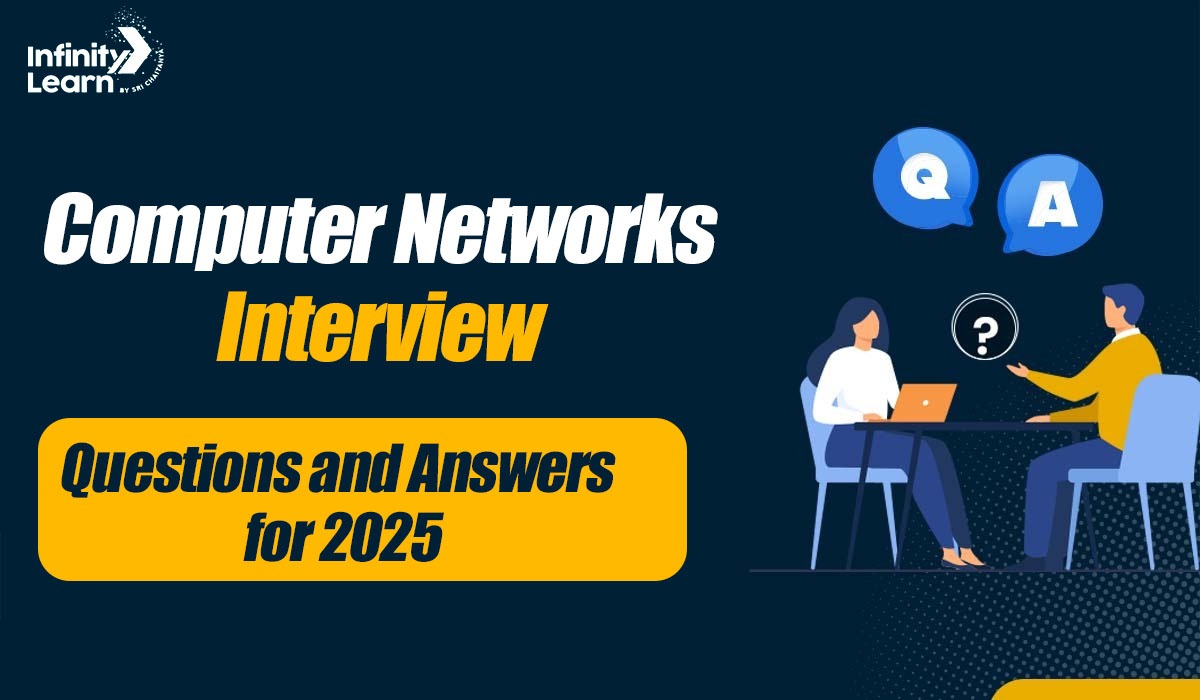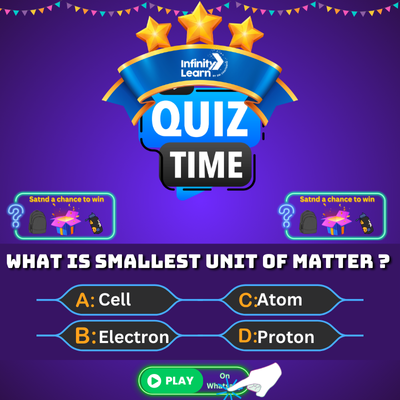Table of Contents
Computer Networks Interview Questions: Computer networks interviews are vital in today’s tech job market, testing skills in areas like network design, security, and troubleshooting. Candidates must grasp core concepts such as the OSI model, TCP/IP protocols, and routing mechanisms, alongside newer trends like cloud integration and 5G.
To stand out, focus on applying theory to real-world scenarios—like optimizing network performance or solving connectivity issues. Highlight problem-solving skills and adaptability, especially as technologies evolve. Stay updated on advancements like software-defined networking to showcase readiness for modern network challenges.

General Networking Interview Questions for 2025
- What initially sparked your interest in networking, and how has that interest evolved over time?
- Can you walk us through a defining moment in your education that influenced your decision to pursue networking?
- What does being a network professional mean to you beyond the technical skills?
- Tell us about a time when you faced a learning curve related to networking. How did you overcome it?
- How do you stay updated with the rapidly changing landscape of networking technologies?
- If you could specialize in one specific area of networking, what would it be and why?
- What personal qualities do you believe are essential for success in the networking industry?
- How has your academic or professional journey prepared you to troubleshoot and manage complex networks?
- Have you ever taken the initiative to implement a new networking solution or process in a past role or project? Tell us about it.
- In your own words, what do you think the future of networking looks like in the next 5–10 years?
- Describe a challenging networking concept you struggled with and how you finally grasped it.
- What do you enjoy most about working in network infrastructure or administration?
- If you had to explain networking to someone with zero technical knowledge, how would you go about it?
- Can you share an example of a time when collaboration with other departments helped you resolve a network issue?
- How do you prioritize tasks when multiple networking issues occur simultaneously?
- What networking project or experience are you most proud of, and why?
- How do you handle stress or pressure during unexpected network outages or emergencies?
- What’s one networking trend or tool you’re currently curious about or learning?
- Have you ever mentored or helped someone else understand a difficult networking topic? What approach did you use?
- What motivates you to continue growing in the networking domain despite challenges or setbacks?
- If given the opportunity, what kind of network would you love to design from scratch?
- Which networking certifications are you aiming to pursue, and what value do you think they bring?
- How would you approach troubleshooting a network problem you’ve never encountered before?
- What ethical considerations do you think network engineers should always keep in mind?
- In your opinion, what distinguishes a good network engineer from a great one?
- Can you describe a time when you had to explain a network issue to a non-technical stakeholder? How did you ensure they understood?
- What kind of team environment helps you thrive as a networking professional?
- If budget or tools were no object, what innovative idea would you bring to a networking team?
- What role does communication play in your day-to-day networking responsibilities?
- If asked to teach a class on networking basics, what key topics would you include and why?
Also Check: How to become a software Engineer
Computer Networks Interview Questions for Freshers (with Answers)
1. What is a computer network?
Answer: A computer network is a system where two or more computers are connected to share resources like files, data, printers, or internet access. These connections can be wired (using cables) or wireless (using Wi-Fi). Networking allows users to communicate and share information easily and quickly.
2. What are the different types of networks?
Answer: There are several types of networks, based on size and purpose:
- LAN (Local Area Network): Covers a small area like an office or home.
- WAN (Wide Area Network): Covers a large area, like cities or countries. The internet is the largest WAN.
- MAN (Metropolitan Area Network): Covers a city or campus.
- PAN (Personal Area Network): Very small, used for personal devices like phones or laptops.
3. What is the difference between a switch and a router?
Answer: A switch connects multiple devices within the same network (like a LAN) and helps them communicate.
A router connects different networks together. It directs data between your home network and the internet.
Think of a switch like a meeting room where team members talk, and a router like a post office that sends and receives letters outside the building.
4. What is an IP address?
Answer: An IP address is a unique number assigned to every device connected to a network. It acts like a digital address, helping devices find each other and communicate over a network.
There are two types:
- IPv4: Example – 192.168.1.1 (uses 4 numbers)
- IPv6: Example – 2001:0db8:85a3::8a2e:0370:7334 (used for more devices, newer)
5. What is DNS and why is it important?
Answer: DNS (Domain Name System) is like a phonebook of the internet. It translates human-friendly domain names (like www.google.com) into IP addresses (like 142.250.190.14) that computers use to connect.
Without DNS, we would have to remember long numbers instead of website names.
6. What is a subnet?
Answer: A subnet (short for sub-network) is a smaller part of a larger network. Subnetting helps organize networks, improve performance, and increase security by dividing the network into logical sections. It reduces traffic and helps in managing devices more efficiently.
7. What is the OSI model and why is it used?
Answer: The OSI model (Open Systems Interconnection) is a standard way of understanding how data moves across a network. It has seven layers:
- Physical
- Data Link
- Network
- Transport
- Session
- Presentation
- Application
Each layer has a specific role, like packaging, addressing, or delivering data. It helps in troubleshooting and designing networks.
8. What is the difference between TCP and UDP?
Answer: TCP (Transmission Control Protocol): Reliable and ensures data is delivered in the correct order. Used for emails, websites, file transfers.
UDP (User Datagram Protocol): Faster but not reliable. Used for live videos, gaming, or voice calls.
Example: TCP is like sending a registered letter, UDP is like sending a postcard.
9. What is a MAC address?
Answer: A MAC (Media Access Control) address is a unique hardware ID assigned to every network device (like a computer or phone). It’s used in local networks to identify devices.
Unlike an IP address, a MAC address is permanent and doesn’t change.
10. What is the purpose of a firewall in a network?
Answer: A firewall is a security system that controls incoming and outgoing traffic in a network. It acts like a barrier between a trusted internal network and the outside world, blocking unauthorized access and protecting against viruses or hackers.
Firewalls can be software (programs) or hardware (devices).
Top 50 Computer Networks Interview Questions MCQs
1. Which OSI layer is responsible for establishing, maintaining, and terminating connections between devices?
A) Data Link Layer
B) Transport Layer
C) Session Layer
D) Network Layer
Answer: C) Session Layer
2. What is the main purpose of subnetting in IP networks?
A) Improve wireless connectivity
B) Increase broadcast range
C) Divide large networks into smaller manageable sections
D) Encrypt transmitted data
Answer: C) Divide large networks into smaller manageable sections
3. Which of the following protocols is used for secure web communication?
A) HTTP
B) FTP
C) HTTPS
D) SNMP
Answer: C) HTTPS
4. In TCP/IP model, which layer corresponds to the Network Layer of OSI model?
A) Network Interface
B) Transport
C) Internet
D) Application
Answer: C) Internet
5. Which protocol resolves IP addresses to MAC addresses?
A) DNS
B) DHCP
C) ARP
D) ICMP
Answer: C) ARP
6. Which device operates at the Data Link Layer and filters traffic based on MAC addresses?
A) Router
B) Switch
C) Repeater
D) Modem
Answer: B) Switch
7. What type of routing algorithm always uses the same fixed path?
A) Adaptive Routing
B) Static Routing
C) Dynamic Routing
D) Flooding
Answer: B) Static Routing
8. In which network topology does every node connect to a central hub?
A) Ring
B) Bus
C) Mesh
D) Star
Answer: D) Star
9. What is the maximum number of IP addresses in a /28 subnet?
A) 8
B) 14
C) 16
D) 30
Answer: B) 14
10. Which protocol is used to assign IP addresses automatically in a network?
A) DNS
B) DHCP
C) SMTP
D) POP3
Answer: B) DHCP
11. Which IP class provides up to 254 host addresses per network?
A) Class A
B) Class B
C) Class C
D) Class D
Answer: C) Class C
12. Which protocol helps in determining the shortest path for data routing?
A) ARP
B) RIP
C) FTP
D) DHCP
Answer: B) RIP
13. Which protocol is used to monitor and manage network devices?
A) SNMP
B) SMTP
C) HTTP
D) DNS
Answer: A) SNMP
14. What is the function of a proxy server?
A) Encrypt traffic end-to-end
B) Connect different LANs
C) Act as an intermediary for requests from clients
D) Control bandwidth
Answer: C) Act as an intermediary for requests from clients
15. What type of attack floods a network with excessive traffic?
A) Phishing
B) Spoofing
C) DDoS
D) Sniffing
Answer: C) DDoS
16. Which port number is used by HTTPS?
A) 21
B) 23
C) 80
D) 443
Answer: D) 443
17. Which layer in the OSI model is responsible for reliable data transfer?
A) Session
B) Data Link
C) Network
D) Transport
Answer: D) Transport
18. Which address type is unique to a physical device?
A) IP Address
B) MAC Address
C) Port Number
D) Hostname
Answer: B) MAC Address
19. What protocol is used for sending emails?
A) FTP
B) SMTP
C) POP
D) IMAP
Answer: B) SMTP
20. Which technology is used to connect networks over long distances using public networks securely?
A) VLAN
B) VPN
C) NAT
D) IDS
Answer: B) VPN
21. What is the size of an IPv6 address?
A) 32 bits
B) 48 bits
C) 64 bits
D) 128 bits
Answer: D) 128 bits
22. Which one of the following is NOT a network layer protocol?
A) IP
B) ICMP
C) TCP
D) OSPF
Answer: C) TCP
23. What does TTL in a packet header stand for?
A) Total Transfer Length
B) Time to Live
C) Transmission Term Limit
D) Traffic Term Limit
Answer: B) Time to Live
24. What device regenerates signals in a network?
A) Hub
B) Repeater
C) Bridge
D) Switch
Answer: B) Repeater
25. Which protocol is used to fetch emails from a server without deleting them?
A) POP3
B) IMAP
C) SMTP
D) SNMP
Answer: B) IMAP
26. What does NAT do in a network?
A) Assigns static IPs
B) Filters malware
C) Maps private IPs to public IPs
D) Blocks HTTP traffic
Answer: C) Maps private IPs to public IPs
27. Which wireless encryption standard is the most secure?
A) WEP
B) WPA
C) WPA2
D) WPA3
Answer: D) WPA3
28. Which command is used to test network connectivity between two devices?
A) ipconfig
B) ping
C) tracert
D) nslookup
Answer: B) ping
29. What is the role of a firewall in a network?
A) Boost signal strength
B) Perform routing
C) Block unauthorized access
D) Translate IP addresses
Answer: C) Block unauthorized access
30. Which technique helps in avoiding packet collisions in Ethernet?
A) TCP handshake
B) CSMA/CD
C) Token passing
D) ARP
Answer: B) CSMA/CD
31. Which protocol does DNS use to resolve hostnames to IP addresses?
A) TCP
B) UDP
C) FTP
D) ICMP
Answer: B) UDP
32. Which switching technique sends data without storing the complete packet?
A) Store-and-forward
B) Cut-through
C) Circuit switching
D) Token passing
Answer: B) Cut-through
33. What is the default subnet mask for a Class B IP address?
A) 255.0.0.0
B) 255.255.0.0
C) 255.255.255.0
D) 255.255.255.255
Answer: B) 255.255.0.0
34. Which layer in OSI deals with encryption and decryption?
A) Network
B) Session
C) Presentation
D) Transport
Answer: C) Presentation
35. What is the primary purpose of ICMP?
A) File transfer
B) Error reporting and diagnostics
C) Email transmission
D) Address translation
Answer: B) Error reporting and diagnostics
36. What type of IP address is 127.0.0.1?
A) Private
B) Public
C) Loopback
D) Broadcast
Answer: C) Loopback
37. Which device can operate on multiple layers of the OSI model?
A) Hub
B) Switch
C) Router
D) Gateway
Answer: D) Gateway
38. What is the main feature of a mesh topology?
A) Central node
B) Shared bus
C) Point-to-point full connectivity
D) Circular communication
Answer: C) Point-to-point full connectivity
39. Which protocol is used for transferring files securely over the Internet?
A) FTP
B) TFTP
C) SCP
D) SNMP
Answer: C) SCP
40. Which port does DNS use for resolving queries?
A) 80
B) 443
C) 53
D) 110
Answer: C) 53
41. Which type of network cable is most commonly used in modern Ethernet networks for wired connections?
A) Coaxial Cable
B) Fiber Optic Cable
C) Twisted Pair Cable
D) HDMI Cable
Answer: C) Twisted Pair Cable
42. What is the primary function of a subnet in IP networking?
A) Encrypt data during transmission
B) Provide wireless access to devices
C) Split a large network into smaller, manageable segments
D) Assign MAC addresses to hosts
Answer: C) Split a large network into smaller, manageable segments
43. Which network cable is most suitable for high-speed, long-distance data transmission without signal degradation?
A) Unshielded Twisted Pair
B) Shielded Twisted Pair
C) Coaxial Cable
D) Fiber Optic Cable
Answer: D) Fiber Optic Cable
44. In DNS, what is the primary purpose of a forward lookup?
A) Convert an IP address into a hostname
B) Store network routing tables
C) Resolve a hostname into its IP address
D) Redirect users to backup servers
Answer: C) Resolve a hostname into its IP address
45. What does the DNS server do when performing a reverse lookup?
A) Translates MAC address to IP
B) Converts a domain name to a URL
C) Finds hostname from a given IP address
D) Forwards data packets to a gateway
Answer: C) Finds hostname from a given IP address
46. What best describes the role of a ‘client’ in a client-server network model?
A) It controls all other systems on the network
B) It provides services to external devices
C) It requests services or resources from a central system
D) It stores backup copies of the network data
Answer: C) It requests services or resources from a central system
47. Which of the following is NOT a valid type of twisted pair cable?
A) Cat 5e
B) Cat 6
C) RG-59
D) Cat 7
Answer: C) RG-59
(Note: RG-59 is a coaxial cable, not a twisted pair.)
48. On which OSI layer does Frame Relay primarily operate?
A) Physical Layer
B) Network Layer
C) Data Link Layer
D) Application Layer
Answer: C) Data Link Layer
49. What key difference separates a server from a client in a network environment?
A) The server is always wireless, the client is always wired
B) Clients assign IP addresses, servers consume them
C) Servers provide shared resources, clients access them
D) Clients route data, servers store it temporarily
Answer: C) Servers provide shared resources, clients access them
50. Why is subnetting important in a network’s architecture?
A) It increases signal strength over long distances
B) It prevents data packet loss in wireless environments
C) It reduces network congestion and enhances security by limiting broadcast domains
D) It eliminates the need for IP addressing
Answer: C) It reduces network congestion and enhances security






